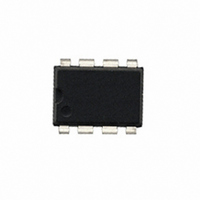604-00038 Parallax Inc, 604-00038 Datasheet - Page 4

604-00038
Manufacturer Part Number
604-00038
Description
IC SENSOR TOUCH/PROXMTY 1CH 8DIP
Manufacturer
Parallax Inc
Series
QProx™r
Type
Capacitiver
Datasheet
1.604-00038.pdf
(12 pages)
Specifications of 604-00038
Touch Panel Interface
1, 2-Wire
Number Of Inputs/keys
1 Key
Resolution (bits)
14 b
Data Interface
Serial
Voltage Reference
Internal
Voltage - Supply
2.5 V ~ 5.5 V
Current - Supply
1.5mA
Operating Temperature
0°C ~ 70°C
Mounting Type
Through Hole
Package / Case
8-DIP (0.300", 7.62mm)
Output Type
Logic
Input Type
Logic
Product
Microcontroller Accessories
Lead Free Status / RoHS Status
Lead free / RoHS Compliant
Interface
-
Lead Free Status / RoHS Status
Lead free / RoHS Compliant, Lead free / RoHS Compliant
4-1 to 4-3). The value of Cs also has a dramatic effect on
sensitivity, and this can be increased in value (up to a limit).
Also, increasing the electrode's surface area will not
substantially increase touch sensitivity if its diameter is
already much larger in surface area than the object being
detected. The panel or other intervening material can be
made thinner, but again there are diminishing rewards for
doing so. Panel material can also be changed to one having
a higher dielectric constant, which will help propagate the
field through to the front. Locally adding some conductive
material to the panel (conductive materials essentially have
an infinite dielectric constant) will also help; for example,
adding carbon or metal fibers to a plastic panel will greatly
increase frontal field strength, even if the fiber density is too
low to make the plastic bulk-conductive.
1.3.5.2 Decreasing Sensitivity
In some cases the QT113 may be too sensitive, even on low
gain. In this case gain can be lowered further by a number of
strategies: making the electrode smaller, making the
electrode
space-to-conductor ratio (Figure 1-3), or by decreasing Cs.
2 - QT113 SPECIFICS
2.1 SIGNAL PROCESSING
The QT113 processes all signals using 16 bit
math, using a number of algorithms pioneered by
Quantum.
designed to provide for high 'survivability' in the
face
changes.
2.1.1 D
Signal drift can occur because of changes in Cx
and Cs over time. It is crucial that drift be
compensated for, otherwise false detections,
non-detections, and sensitivity shifts will follow.
Sen se
Figure 1-5
wire
of
RIFT
U nshielded
Electrode
numerous
into
C
The
OMPENSATION
Shielding Against Fringe Fields
algorithms
a
sparse
adverse
A
LGORITHM
are
Sense
wire
mesh
environmental
specifically
E lec trode
S hielded
using
a
T hr es ho ld
O u tpu t
high
- 4 -
Drift compensation (Figure 2-1) is performed by making the
reference level track the raw signal at a slow rate, but only
while there is no detection in effect. The rate of adjustment
must be performed slowly, otherwise legitimate detections
could be ignored. The QT113 drift compensates using a
slew-rate limited change to the reference level; the threshold
and hysteresis values are slaved to this reference.
Once an object is sensed, the drift compensation mechanism
ceases since the signal is legitimately high, and therefore
should not cause the reference level to change.
The QT113's drift compensation is 'asymmetric': the
reference level drift-compensates in one direction faster than
it does in the other. Specifically, it compensates faster for
decreasing signals than for increasing signals. Increasing
signals should not be compensated for quickly, since an
approaching finger could be compensated for partially or
entirely before even approaching the sense electrode.
However, an obstruction over the sense pad, for which the
sensor has already made full allowance for, could suddenly
be removed leaving the sensor with an artificially elevated
reference level and thus become insensitive to touch. In this
latter case, the sensor will compensate for the object's
removal very quickly, usually in only a few seconds.
With large values of Cs and small values of Cx, drift
compensation will appear to operate more slowly than with
the converse. Note that the positive and negative drift
compensation rates are different.
2.1.2 T
Unlike the QT110 device, the internal threshold level is fixed
at one of two setting as determined by Table 1-1. These
setting are fixed with respect to the internal reference level,
which in turn can move in accordance with the drift
compensation mechanism..
The QT113 employs a hysteresis dropout below the
threshold level of 17% of the delta between the reference and
threshold levels.
2.1.3 M
If an object or material obstructs the sense pad the signal
may rise enough to create a detection, preventing further
Table 1-1 Gain Setting Strap Options
Low - 12 counts
High - 6 counts
Figure 2-1 Drift Compensation
HRESHOLD
AX
Gain
O
S ign a l
N
-D
URATION
R e fe re nce
C
ALCULATION
Tie Pin 5 to:
H yste resis
Vss (Gnd)
Vdd





















